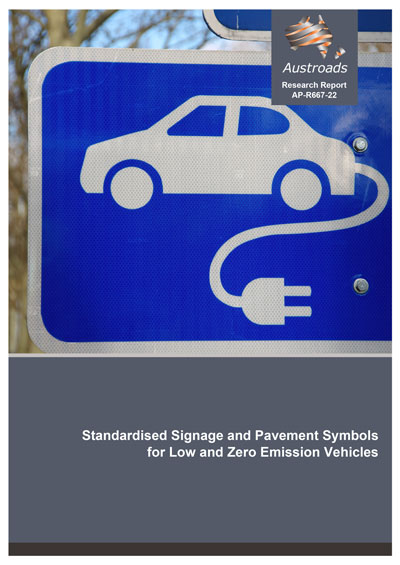Low and Zero Emission Vehicles

- Publication no: AP-R667-22
- ISBN: 978-1-922700-28-5
- Published: 5 December 2022
- PDF (free) Download
This report, published in January 2022, provides a basis for future testing and standardisation of the symbols and road signage for low and zero emission vehicles in Australia and New Zealand, paving the way to adopt consistent symbols in the road rules and signage manuals of jurisdictions. It proposes a set of symbols for electric-powered and hydrogen fuel-cell powered vehicles and their charging/refuelling infrastructure.
The symbol proposals are based on national and international evidence and trials as well as feedback from road agencies in Australia and New Zealand and key industry organisations. Five symbol/signage categories are considered: electric-powered vehicle, electric-powered vehicle being charged, charging station for electric-powered vehicle, hydrogen fuel‑cell powered vehicle and refuelling infrastructure, and lane access for low and zero emission vehicles. Multiple symbol/sign options are provided for consideration where appropriate.
Watch a webinar with reports authors Dr Robert Kochhan, Paul Hayes and Dr Clarissa Han.
 In December 2022 an addendum was published summarising the testing results of the symbols proposed in Austroads Research Report AP-R667-22.
In December 2022 an addendum was published summarising the testing results of the symbols proposed in Austroads Research Report AP-R667-22.
Testing was conducted according to Australian Standard AS 1743:2018. The results show that electric-powered vehicle and charging station symbols were well understood by the public. However, hydrogen fuel-cell powered vehicle and hydrogen refuelling station symbols did not pass the test.
It is concluded that the electric-powered vehicle and charging station symbols are considered suitable for use on future road signage and pavement markings. However, as the public’s awareness of hydrogen as a fuel is still low, testing of hydrogen-related symbols should be repeated in the future, or the design of or need for such symbols should be reconsidered.
- Summary
- 1. Introduction
- 1.1 Purpose
- 1.2 Scope
- 1.3 Methodology
- 2. Review of Existing Signage and Road Markings
- 2.1 Category 1: Electric-powered Vehicle
- 2.2 Category 2: Electric-powered Vehicle being Charged
- 2.3 Category 3: Charging Station for Electric-powered Vehicles
- 2.4 Category 4: Hydrogen Fuel-cell Powered Vehicle
- 2.5 Category 5: Access to Lanes and Roadways Designated for Electric-powered Vehicles and Hydrogen Fuel-cell Powered Vehicles
- 3. Stakeholder Consultations
- 4. Methodology
- 5. Recommendations for LZEV Signage and Road Markings
- 5.1 Category 1: Electric-powered Vehicle
- 5.2 Category 2: Electric-powered Vehicle being Charged
- 5.3 Category 3: Charging Station for Electric-powered Vehicles
- 5.4 Category 4: Hydrogen Fuel-cell Powered Vehicle
- 5.5 Category 5: Access to Lanes and Roadways Designated for Electric-powered Vehicles and Hydrogen Fuel-cell Powered Vehicles
- 5.6 Symbol Testing
- 6. Summary of Symbols and Recommendations
- References
- Appendix A Stakeholder Consultation Summaries
- A.1 Main Roads Western Australia and Queensland Department of Transport and Main Roads
- A.2 Transport for New South Wales
- A.3 Victoria Department of Transport and Northern Territory Department of Infrastructure, Planning and Logistics
- A.4 Waka Kotahi/New Zealand Transport Agency, Transport Canberra and Australian Automobile Association
- A.5 South Australian Department for Infrastructure and Transport
- A.6 National Transport Commission
- A.7 MS-012 Committee
- A.8 Federal Chamber of Automotive Industries
- A.9 Everty (Electric Vehicle Council) and Truck Industry Council
- A.10 Tesla Owners Club
